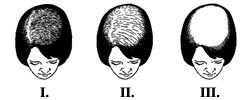FAQ
What causes hair loss in women?
Unfortunately, the phenomenon of hair loss is becoming increasingly prevalent among women. If hair suddenly starts falling out in tufts, this is known as diffuse hair loss.

This has various different causes, including organic causes such as thyroid malfunction, infections with a fever, serious surgery, taking certain medications, or crash diets. Stress and psychological strain are in particularly playing an increasing role for women. However, women suffer at least as often from thinning of the hair in the crown area, with the scalp suddenly becoming visible – a huge shock! This hereditary/hormonal hair loss generally first becomes noticeable over time, as it typically does not involve sudden major hair loss. It usually affects women who already have rather thin, fine hair – and who are then hit especially hard.
Some women also experience sudden hair loss after pregnancy or the menopause. Hormonal imbalance causes hair loss which is generally suffered by women who have a genetic predisposition to it.
Alopecia areata (spot baldness) also occurs very suddenly. It generally only appears on isolated patches of the scalp, but in extreme cases hair loss can also result in baldness not restricted to the head. It is assumed that this is the result of an autoimmune response from the body.
Stages of alopecia in women:
Hereditary/hormonal hair loss in women typically develops as follows:
- Stage 0: Normal hair growth.
- Stage I: The beginnings of hair thinning in the crown area; only visible when parting the hair; frontal fringe 1-3 cm wide already discernible. Hair pull test positive.
- Stage II: Marked, visible hair thinning in the crown area. Frontal fringe 1-3 cm wide clearly apparent.
- Stage III (rare): Pronounced balding in the frontoparietal area, the frontal fringe remains.
 Deutsch
Deutsch English
English Français
Français Italiano
Italiano